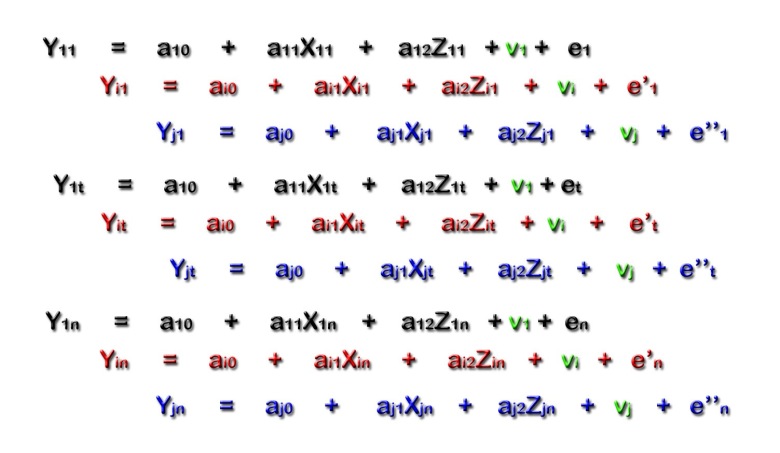Continuing from previous version of Regression Analysis DNA, this version has incorporated the cross sections and as well as panel data properties and issues. Due to limitation of 3D image construction skills, most of the description is explained in terms of words instead of diagram, use of colors are on purpose to distinguish and understand the diagram easily.
Types of Regression models:
First we will explain the fundamental regression models from this diagram. There are three major types of models Cross sectional Model, Time series Model and Panel data model.
- If we just pick up same colored equation like Black, Red or Blue only, it means there is only one entity which is being discussed across time from 1 to n. This is time series model.
- If we just pick up first set with one of Black, Red and Blue then it means here we have only one time period but there are several entities from 1 to j. This is Cross sectional model
- But if we pick up the whole set with three each of Black, Red and Blue, it will mean that there are several entities from 1 to j which are being studies across time from 1 to n. This is panel data model.
If we are not making panel data then what we can do is to run regression of time series model for each cross-section separately, hence there will be j regression equations analyzed up to time n. Consequently we can do the exact opposite, to make a cross-section equation of j entities and have separate n equations for each time period. Here we can advocate the benefit of panel data that while running so many (depends on j or n) equations separately, we are generating a new error term for each regression each time. As we know that every entity stays almost the same throughout the time and also most of the entities which are under consideration for certain theory are also interconnected, hence all of the error terms will have some interconnection among each other which we call Contemporaneous Correlation, making the panel data uses this extra information to make model more efficient and it is expected that it improves the results too.
But when we make a panel data model, our error term becomes two-dimensional, error because of time and error because of difference in entity that is why we have two error terms mentioned v and e. Because of this v, some complex panel data models are used which are Fixed effect model and Random effect model.
